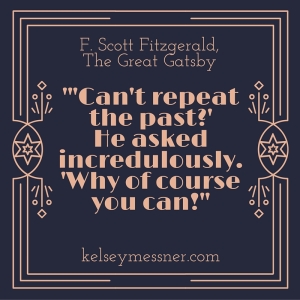 The more Nick Carraway spends time with Jay Gatsby, the more he realizes that there is some mystery, some deeply affecting mission which drives his neighbor to abandon reason and logic in pursuit of one thing: the green light on Daisy’s dock.
The more Nick Carraway spends time with Jay Gatsby, the more he realizes that there is some mystery, some deeply affecting mission which drives his neighbor to abandon reason and logic in pursuit of one thing: the green light on Daisy’s dock.
When Nick first encounters Gatsby, he sees him outside the mansion at night.
“He stretched out his arms toward the dark water in a curious way, and, far as I was from him, I could have sworn he was trembling. Involuntarily I glanced seaward—and distinguished nothing except a single green light, minute and far away, that might have been the end of a dock. When I looked once more for Gatsby he had vanished, and I was alone again in the unquiet darkness.” (Fitzgerald, 20-21)
It is important to note that the first time the men meet, Gatsby is seen outside of his mansion, outside of the wealth and pomp that have defined him in West Egg. This is an uncharacteristically vulnerable moment for Gatsby. The man known for his extravagant displays of wealth, constantly surrounded by hundreds of important people, a man of mystery and poise is stripped of his material goods, alone, holding out trembling arms toward this distant green light. This image gives us a glimpse into what Gatsby is about, what he is really searching for. It also infers that his wealth and semblance of material and reputational success have little to do with it—an idea we will explore more next week.

But what is this green light that has him transfixed?
As with any literary device, symbols such as these are up for debate. Many believe, rightfully so, that the green light represents the uncertain future. Others, that the light represents the American Dream. I do not disagree with these ideas, but I would like to explore another perspective in the following paragraphs.
For a time, I believed that the green light symbolizes Gatsby’s Idea of Daisy. He pines after this lady, this perfect woman on a pedestal of nostalgia, a person who no longer truly exists. His quest is to be reunited with her and to share the future together.
But why Daisy? Why now?
The romantic side of me would like to believe that Gatsby truly is in love with Daisy and that he has been waiting for the opportune moment to profess his intentions. The more logical side knows that there is something deeper going on here, something more engrossing than emotion and more compelling than obsession.
One layer of Gatsby’s mission is the need for power. Once jilted for his lack of wealth, he now seeks to prove his worth, both monetary and individual, by stripping Tom, Daisy’s husband, of that worth.
After Gatsby’s party, which Daisy and Tom attended, Gatsby and Nick talk about how she liked the party, her impressions, and the future. Nick relates:
“He wanted nothing less of Daisy than that she should go to Tom and say: ‘I never loved you.’ After she had obliterated four years with that sentence they could decide upon the more practical measures to be taken. One of them was that, after she was free, they were to go back to Louisville and be married from her house—just as if it were five years ago.” (Fitzgerald, 109)
Certainly part of Gatsby’s reason for asking this of Daisy is to prove her love for him, but another purpose is to siphon power away from Tom. If Daisy says she never loved Tom, Gatsby can take the pride in having held her affection all those years, a position which asserts his worth above Tom’s.
We see another vulnerable moment here, when Carraway challenges Gatsby’s expectations of Daisy:
 “‘I wouldn’t ask too much of her,’ I ventured. ‘You can’t repeat the past.’
“‘I wouldn’t ask too much of her,’ I ventured. ‘You can’t repeat the past.’
“‘Can’t repeat the past?’ he cried incredulously. ‘Why of course you can!’
“He looked around him wildly, as if the past were lurking here in the shadow of his house, just out of reach of his hand.
“‘I’m going to fix everything just the way it was before,’ he said, nodding determinedly. ‘She’ll see.’” (Fitzgerald, 110)
This gives us such a great insight into Gatsby’s character. After all these years of things working out for him, of meeting Dan Cody and obtaining the wealth he never dreamed possible, he believes he can go back in time and fix the one thing that was broken: his relationship with Daisy.
Here, we find that deep, psychological drive behind his pursuit. It’s more than love, more than power, and more transient than wealth.
Essentially, the green light is a search for identity and self-actualization. Gatsby believes that if he can gain the love of the woman who once discarded him, he will find peace within himself. He will also have proof, through marriage, to offer the world that he is a valuable human being.
Gatsby’s story reminds me of an Old Testament hero who also had fulfillment issues surrounding relationships with women. Samson, a man blessed by God with supernatural strength, seemingly has everything he could possibly desire. With God’s power, he defeats a lion and the Philistines. But Samson has some issues as far as women are concerned.
First, Samson insists on marrying a Philistine woman, even though the Israelites were constantly at war with them. His parents asked if there was anyone else, to which Samson declares, “Get her for me, for she pleases me well.” (Judges 14: 3)
If this woman did indeed “please” Samson as he believed she would, one would imagine that he would be content in that relationship. Not so with Samson. After getting into a heated argument over a riddle, Samson gives his wife to the best man from the wedding. Then, the author of Judges makes a point of sharing that Samson visited a harlot while in Gaza, and then that he “loved a woman in the Valley of Sorek, whose name was Delilah.” (Judges 16:4)
We all know how well that relationship went.
Samson, in a word, seems unsettled. Despite his good standing, strength, and valor, he needs to have a woman in his life to prove something. To prove his value, his allure, or maybe to curb loneliness. Sounds familiar to Gatsby’s need—a drive for fulfillment that can never actually be realized.
People have different goals, motivations, and dreams in life, but I think we all have some variation of Gatsby’s Green Light syndrome. There is this one thing that we fixate on, believing that when we obtain it, we will find purpose or meaning or affirmation.
We can learn from Samson’s shining moment in history; his most vulnerable hour—standing in the temple of the Philistines. Hair shorn, muscles weakened, eyes gouged out, Samson is led by a boy to lean on the pillars. There, stripped of all power, Samson calls out to God, recognizing that his strength and identity is in God and glorifying Him.
“O Lord God, remember me, I pray! Strengthen me, I pray, just this once, O God, that I may with one blow take vengeance on the Philistines for my two eyes.” (Judges 16:28)
God grants Samson’s request and defeats the Philistines. This only happens when Samson recognizes his mistakes and his desperate need for God, and God responds in a mighty way.
Are you looking for meaning in material things? In prestige, or wealth, or romantic conquests? I know I’ve been all too guilty of this. But the beautiful thing is, God promises us that we will have life in Him. Romans 6:20-23 says:
“For when you were slaves of sin, you were  free in regard to righteousness. What fruit did you have then in the things of which you are now ashamed? For the end of those things is death. But now having been set free from sin, and having become slaves of God, you have your fruit to holiness, and the end, everlasting life. For the wages of sin is death, but the gift of God is eternal life in Christ Jesus our Lord.”
free in regard to righteousness. What fruit did you have then in the things of which you are now ashamed? For the end of those things is death. But now having been set free from sin, and having become slaves of God, you have your fruit to holiness, and the end, everlasting life. For the wages of sin is death, but the gift of God is eternal life in Christ Jesus our Lord.”
What a hope we have in Christ. He gives us our identity, our purpose. We need nothing more, because there is nothing greater than that promise.
I challenge you to pray about whatever green light unsettles you in your life. Address this weakness, and talk to God about why you have these feelings. Seek wisdom from God. He loves you, and He wants you to live by His power, His strength, and most of all, in His love.
 God graciously extends His mercy to us, but we must be willing to accept it in order for the power to affect our lives. As we’ve discussed, Hester Prynne has confessed her sins to God and walks with new life in Hawthorne’s The Scarlet Letter. She accepted God’s mercy, whereas Arthur Dimmesdale has been unable to find peace after stumbling.
God graciously extends His mercy to us, but we must be willing to accept it in order for the power to affect our lives. As we’ve discussed, Hester Prynne has confessed her sins to God and walks with new life in Hawthorne’s The Scarlet Letter. She accepted God’s mercy, whereas Arthur Dimmesdale has been unable to find peace after stumbling. “You wrong yourself in this . . . You have deeply and sorely repented. Your sin is left behind you, in the days long past. Your present life is not less holy, in very truth, than it seems in people’s eyes. Is there no reality in the penitence thus sealed and witnessed by good works? And wherefore should it not bring you peace?” (Hawthorne, 131)
“You wrong yourself in this . . . You have deeply and sorely repented. Your sin is left behind you, in the days long past. Your present life is not less holy, in very truth, than it seems in people’s eyes. Is there no reality in the penitence thus sealed and witnessed by good works? And wherefore should it not bring you peace?” (Hawthorne, 131) “For it is by grace you have been saved, through faith–and this is not from yourselves, it is the gift of God–not by works, so that no one can boast. For we are God’s handiwork, created in Christ Jesus to do good works, which God prepared in advance for us to do.”
“For it is by grace you have been saved, through faith–and this is not from yourselves, it is the gift of God–not by works, so that no one can boast. For we are God’s handiwork, created in Christ Jesus to do good works, which God prepared in advance for us to do.”
 Got knows that in our sinful nature, we will make mistakes. That is inevitable. But what He calls us to do is to recognize the gift of redemption He has given us in His Son, Jesus Christ. Jesus took our sins to the cross so that we could have life. Refusing to give our shame over to Him limits our ability to recreate us.
Got knows that in our sinful nature, we will make mistakes. That is inevitable. But what He calls us to do is to recognize the gift of redemption He has given us in His Son, Jesus Christ. Jesus took our sins to the cross so that we could have life. Refusing to give our shame over to Him limits our ability to recreate us. cover the mark as she will, the pang of it will be always in her heart.’
cover the mark as she will, the pang of it will be always in her heart.’ “But Jesus stooped down and wrote on the ground with His finger, as though He did not hear. So when the continued asking Him, He raised Himself up and said to them, ‘He who is without sin among you, let him throw a stone at her first.’
“But Jesus stooped down and wrote on the ground with His finger, as though He did not hear. So when the continued asking Him, He raised Himself up and said to them, ‘He who is without sin among you, let him throw a stone at her first.’ The more Nick Carraway spends time with Jay Gatsby, the more he realizes that there is some mystery, some deeply affecting mission which drives his neighbor to abandon reason and logic in pursuit of one thing: the green light on Daisy’s dock.
The more Nick Carraway spends time with Jay Gatsby, the more he realizes that there is some mystery, some deeply affecting mission which drives his neighbor to abandon reason and logic in pursuit of one thing: the green light on Daisy’s dock.
 “‘I wouldn’t ask too much of her,’ I ventured. ‘You can’t repeat the past.’
“‘I wouldn’t ask too much of her,’ I ventured. ‘You can’t repeat the past.’ free in regard to righteousness. What fruit did you have then in the things of which you are now ashamed? For the end of those things is death. But now having been set free from sin, and having become slaves of God, you have your fruit to holiness, and the end, everlasting life. For the wages of sin is death, but the gift of God is eternal life in Christ Jesus our Lord.”
free in regard to righteousness. What fruit did you have then in the things of which you are now ashamed? For the end of those things is death. But now having been set free from sin, and having become slaves of God, you have your fruit to holiness, and the end, everlasting life. For the wages of sin is death, but the gift of God is eternal life in Christ Jesus our Lord.” Summary
Summary
 Summary
Summary



